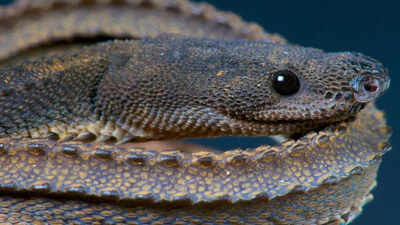ARTICLE AD BOX

The dragon snake (Xenodermus javanicus) is one of the most mysterious and visually striking reptiles, often admired for its dragon-like scales and shadowy appearance. Native to the humid forests and wetlands of Southeast Asia, this snake is as fascinating as it is fragile.
Despite its mythical look, the dragon snake is notoriously difficult to care for in captivity, with strict dietary, environmental, and behavioural needs that make it unsuitable for beginners. For experienced reptile enthusiasts, however, its unique traits offer a rare glimpse into one of nature’s most elusive species, blending beauty, mystery, and challenge in equal measure.
Physical characteristics of the dragon snake

Source: Wikipedia
Dragon snakes are slender reptiles, averaging between 2 and 3 feet (0.6–0.9 metres) in length.
Their most distinctive feature is their rough, ridged scales that run along their backs, giving them a dragon-like appearance. These keeled scales are unique in texture, making the snake stand out among other species in the region.Their body is generally dark brown or almost black, while the underside is noticeably lighter, creating a sharp contrast. The head is slightly broader than the neck, giving them a triangular shape that adds to their fierce yet elegant look.
Because of their unique texture, dragon snakes are often called by other common names, including the Javan tubercle snake, the Javan mud snake, and the rough-backed litter snake. Despite these many names, they all refer to the same species: Xenodermus javanicus.
Habits and challenges of the dragon snake

Source: Wikipedia
Distribution and subspecies
Unlike many snake species with multiple subspecies, dragon snakes exist as a single species. They are found in the damp, forested regions of Indonesia, Malaysia, and Thailand.
These areas provide the moisture, dense cover, and soil conditions that the snakes rely on for survival.Their limited distribution, combined with their secretive nature, makes them a rare sight in the wild. This rarity also contributes to their mystique and growing popularity among reptile enthusiasts, though keeping them in captivity comes with considerable challenges.
Natural habits of the dragon snake
Dragon snakes are primarily nocturnal and semi-fossorial, meaning they spend much of their time burrowed underground or hidden beneath leaf litter.
At night, they emerge to hunt or move between burrows. This lifestyle allows them to stay protected from predators while conserving energy in their humid forest environment.These snakes are highly secretive and solitary, rarely seen interacting with one another except during the breeding season. In captivity, their need for hiding spots is critical—without them, they often experience high levels of stress. Recreating their natural behaviour requires enclosures with soft, loose substrate for burrowing, plenty of leaf litter, and access to water.Because of their elusive nature, even herpetologists studying them in the wild have difficulty observing their habits. This makes them mysterious creatures that remain poorly understood compared to more common reptiles.
The diet of the dragon snake
In their natural environment, dragon snakes primarily feed on small amphibians and fish. They have adapted to hunting near shallow water sources, where they can ambush unsuspecting prey.Feeding dragon snakes in captivity is particularly challenging.
Many individuals refuse standard reptile foods such as rodents, instead requiring live feeder fish like mosquito fish or guppies. Their inconsistent feeding behaviour is one of the main reasons they are considered unsuitable for beginners.
Environment and care needs
Dragon snakes thrive in humid, forested environments with loose, damp soil. They are often found near wetlands, streams, or rice paddies, where moisture levels remain high year-round.Replicating these conditions in captivity requires precise control over humidity and temperature. Enclosures must include naturalistic elements such as leaf litter, hides, and a water source. Substrates should allow burrowing, and stress must be minimised by reducing handling.Most dragon snakes available in the pet trade are wild-caught, and many fail to adapt to captivity due to improper housing or diets.
Captive-bred individuals are rare but represent a more ethical and sustainable choice.
Life cycle and reproduction
Dragon snakes have a relatively low reproductive rate. Females typically lay a small clutch of eggs in hidden, moist areas where the humidity remains stable. The incubation process lasts until the delicate hatchlings emerge.Breeding this species in captivity is difficult because of their precise environmental requirements.
Hatchlings are even more fragile than adults, requiring carefully maintained conditions and small live prey to survive.
Conservation concerns
Although dragon snakes are not currently listed as endangered, their specialised habitat makes them vulnerable to environmental change. Deforestation, agricultural expansion, and habitat destruction in Southeast Asia could threaten their long-term survival.Another concern is the reptile trade. Wild-caught dragon snakes are often collected for export, but many do not survive long in captivity.
This creates both ethical and conservation issues, highlighting the importance of leaving wild populations undisturbed and focusing on captive-bred specimens.The dragon snake’s beauty and mystery are best appreciated in the wild, where the species thrives in its natural rainforest and wetland habitats. For most people, observing them through documentaries, research, or photography may be a more sustainable and rewarding choice.Also Read: 8 largest octopuses ever found around the world



.png)
.png)
.png)
















 9 hours ago
4
9 hours ago
4








 English (US) ·
English (US) ·